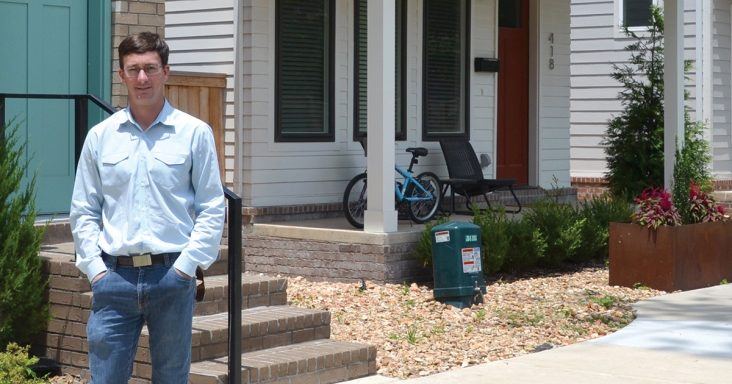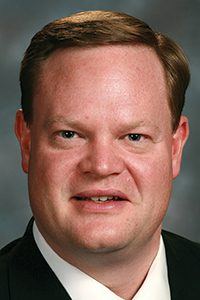In downtown, what’s old is becoming new again
by July 17, 2017 11:50 am 1,805 views

Jake Newell, owner of Bentonville firm Newell Development, is building homes along B Street in Bentonville where residents can live a walkable, bikeable lifestyle.
For decades the heart and soul of every community across America was its downtown. Families traded at the local grocery store, children rode their bikes along tree-lined sidewalks, neighbors stopped to hear the latest gossip as they met on the street, and people lived life — from their work to their play — all in close proximity. Downtowns were the heartbeat of the community, and they flourished as the focal point of business and community life.
But with rising incomes, growing ownership of cars, the trend toward larger homes and other factors, people and businesses began moving away from the city center. Downtowns declined.
In nearly every American city between 1950 and 1980, downtown populations fell, and suburban populations increased, as people fled the city center for jobs and new neighborhoods increasingly located away from town.
But don’t count downtowns out. They are back, and the evidence is strong in cities like Charleston, S.C., Austin, Texas, Nashville, Tenn., and all across the United States.
People and businesses are moving back into downtowns, and there is a revitalization of existing buildings and a densification as new buildings are built in open or reclaimed spaces, said Jeremy Hudson, CEO of Specialized Real Estate Group and chair of the NWA Urban Land Institute district council.
“For a while it was in a lot of major cities, and now it’s really beginning to move into some of the secondary and tertiary markets, like our own,” Hudson said.
People are moving back to the heart of the city because of what they left behind: an opportunity to live and work and play all in the same location.
“It’s absolutely a trend that is happening all over the country where people and businesses are moving back into downtown existing cores, because they are typically some of the most walkable and bikeable parts of the city, with the most character and the most businesses and community services, and restaurants,” Hudson said.
A survey done by the Urban Land Institute reported that 50% of people said walkability is a top or high priority when considering where to live, and more than half would like to live in a place where they do not need to use a car “very often.”
The move is driven, in large part, by the two largest age groups in the country, the millennial generation and baby boomers, Hudson said.
“The millennial demographic is the first real age group that has ever made location the basis of where they’re going to live,” Hudson said. “They are choosing where they want to live first and the job second, so that’s why you’ve seen a lot of cities like Denver, Nashville, Buffalo, Fort Collins, all kinds of cities that didn’t used to be what they are now. The influx of millennials has really changed those cities.”
At the same time, baby boomers are choosing to downsize in retirement and want to live in a location where they can enjoy an active lifestyle.
‘GROWING DEMAND’
Jake Newell, CEO of Bentonville firm Newell Development, said he believes the housing demand in the city is being driven by the national trend.
“Many people move here from markets like Austin or San Francisco where they lived a walkable lifestyle, and that’s what they want when they move to Bentonville,” he said.
Cities are responding to the growing demand for the downtown lifestyle with a revitalization of historic downtowns, renovation of old buildings and new urbanism.
New urbanism is “a planning and development approach based on the principles of how cities and towns have been built for the last several centuries: walkable blocks and streets, housing and shopping in close proximity and accessible public spaces,” according to the Congress for New Urbanism.
In response to the demand, revitalization and new urbanism have come calling throughout many of NWA’s downtowns, too.
Rogers and Bentonville are two prime examples. Both municipalities have worked to facilitate private investments and development with the creation of long-term master plans, infrastructure improvements and rezoning.
Due to the demand, more housing options with greater density are being built in city centers, just like in the original downtowns, said Troy Galloway, community and economic director for the city of Bentonville.
“It was much more common to have a variety of housing types from larger single-family homes to walk-up apartment buildings and loft-over apartments and for businesses to have business on the first floor and livin

g units on the second and/or third floor. And all that to be done within the fabric of the same neighborhood,” Galloway said.
Both cities are seeing demand rise for everything from large single-family homes to one-bedroom apartments, developer Rustin Chrisco said.
“There’s a group of people affluent, retired or close to retired, who are buying larger homes or who are tearing down houses and building larger homes in the downtown area,” Chrisco said. “And we’ve got a group of younger people who aren’t interested in the larger homes. They’re more interested in a more urban lifestyle, and they don’t want all that stuff to burden them down.”
But the common denominator is the walkable lifestyle that is close to work, home and play.
“We have several tenants that don’t own cars,” Newell said. “They work at the [Wal-Mart] home office, they Uber to the airport, and they ride their bike and walk,” Newell said.
Rogers Mayor Greg Hines said the key to a successful downtown is people living there.
“I’ll say it till I’m blue in the face: it’s not about attracting the right business to downtown. It’s absolutely 100% about getting enough people living in the downtown area that their wants and needs dictate what businesses are in those storefronts.”
Hines said downtown Rogers is well on the way to once again being a place where people live, work and play all in close proximity.
“Twenty-four months from now you’re going to see more people have moved into downtown,” he said. “And you’re going to be hard-pressed when you’re not seeing families walking up and down the sidewalks, and they’re not walking because they’ve parked the car. They’re walking because they got out the front door and came down to have dinner or to shop.”
